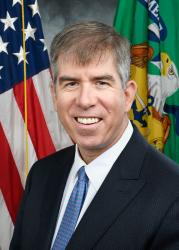The working behavior and participation rates of older workers in the labor force have shifted substantially in recent decades. Although much of the 3.1 percentage point decline in U.S. labor force participation from 2007 to 2018 can be connected to an increased aging population (the share of the U.S. population over the age of 65 has increased from 15.6 to 19.9 percent in the last 12 years), the explanation for this trend extends far beyond a population aging out of the workforce.
Labor force participation is rising for older workers in the U.S.; therefore, while it is tempting to focus on prime-age workers to gauge the economy’s health to avoid demographic effects, doing so misses important shifts amongst those over 54 years old.
Figures 1a and 1b (below) show labor force participation rates by gender, birth cohort, and age in five–year intervals. These figures describe both trends in labor force participation by age and whether levels and patterns in labor force participation have changed across generations. Since labor force participation is a substantial determinant of output and living standards over time, these numbers and trends are significant.
In general, the broad trends for men and women are different: recent cohorts of women (across age spans) have been participating at higher rates than their predecessors early in life but lower rates in middle age, while recent cohorts of men have been participating at lower rates throughout prime-age years. However, those currently ages 60 to 64 (purple)—men and women alike—are both still working at higher rates than their prior cohorts.

During the Great Recession and earlier stages of the recovery, overall participation rates fell quite far. In fact, the U.S. labor market did not effectively reverse the decline that occurred after 2007 until 2018 after a strong rebound in the last three to four years. (The demographically-adjusted employment rate but not the participation rate was back to 2007 levels in 2018 because of declining unemployment during this period.)
To measure the importance of the rising rates of older workers in the labor force, we decompose the changes in overall labor force participation into changes in the age composition of the adult population and changes in the propensity of each age group to work. We found that aging contributed 2.7 percentage points to the 3.1 percentage point decline, while changes in participation contributed just 0.4 percentage points.
Yet this small contribution of participation rate changes to the overall decline masks the sizable shifts within gender-age groups shown in figure 2 (below):
- It is young people—particularly young men—who have driven the overall participation rate down between 2007 and 2018.
- In total, the declining participation of prime-age or younger workers led the overall participation rate to decline by 1.14 percentage points.
- By contrast, the participation of men and women age 55 and older raised the overall rate by 0.73 percentage points.

Can older individuals be expected to continue to maintain a higher level of participation than in the past? Lower participation rates of those over 54, relative to other demographic groups, may suggest sizable room for growth. However, it is worth examining whether the reasons that older men and women gave for their nonparticipation in the labor force meet this expectation.

Figure 3 (above) describes the reasons that 55- to 64-year-old men and women gave when asked why they did not work for pay in 2014 (note: the sample is limited to those who were labor force nonparticipants for the entire year). While the figure shows the distributions of reasons for their nonparticipation, about 7 million women were nonparticipants as compared to about 5 million men. When these differences in the size of the population are taken into account, we find that:
- 1.8 million men and 3.2 million women were retired, not interested in working, or were out of the labor force for work-related issues and could potentially return to the workforce.
- 2.8 million men and 3.6 million women—the majority of nonparticipants—report health conditions or caregiving obligations as their reason for not working for pay in 2014.
If the trend of rising labor force participation among older workers will be central to continued future growth, it will be critical for policymakers to address labor force exits and to support workforce reentry for 55- to 64-year-old nonparticipants. While the health of older Americans as a group has improved over time, these improvements are being driven by middle- and higher-income people while low-income people of all ages have experienced deteriorating health. Policy plays a role in addressing the growing prevalence of health- or caregiving-related issues and to support older workers who do want to remain in the workforce.
The Brookings Institution is committed to quality, independence, and impact.
We are supported by a diverse array of funders. In line with our values and policies, each Brookings publication represents the sole views of its author(s).









Commentary
Is the continued rise of older Americans in the workforce necessary for future growth?
April 4, 2019